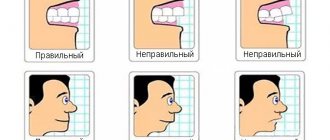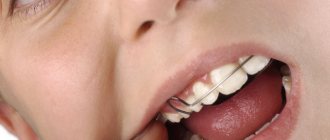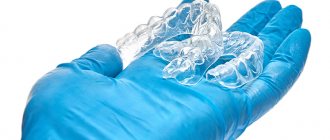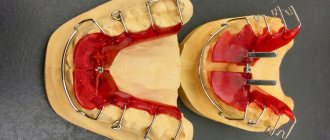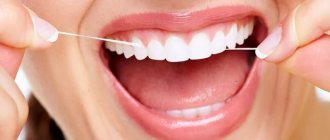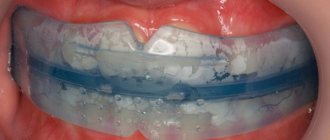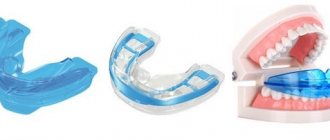This is a frequently asked question on health forums, and we're here to answer it. Beautiful and healthy teeth are not an easy task. Here you need to follow the recommendations of a specialist, a visit to the dentist and the appropriate model and company that manufactures the trainers. The process and speed of obtaining the first results depends on this.
Night guards are useful not only for children, but also for adults, since it is a universal system and has no age restrictions. The model is designed to prevent and combat dental anomalies. For adults, this is a real salvation, since you can fix even what is neglected.
Before purchasing a trainer, you need to consult with an orthopedist; he will tell you about the treatment method and select the right model.
When a doctor recommends correction with trainers
Trainers are used to straighten teeth when a patient is diagnosed with a malocclusion. Pathology can have different manifestations, so the possibility of wearing a corrector to obtain an effective result is assessed by the orthodontist individually for each patient.
In certain cases, trainers can replace a brace system if they have contraindications to wearing it. However, the corrective abilities of trainers are inferior to braces, although only slightly.
Other indications for wearing orthodontic trainers:
- deviation in tooth growth (location, direction, etc.);
- swallowing dysfunction;
- pathologies of the oral cavity leading to chronic nasal congestion.
The peculiarity of the device lies in its effect on the cause of the disease. Wearing trainers helps develop the jaw muscles, reduce pressure on the jaw bones, restore breathing through the nose and correct tongue position.
For whom are they contraindicated?
Correction with an orthodontic device to correct the bite may not always be carried out. Experts advise postponing the start of treatment in case of exacerbation of chronic diseases, especially those associated with impaired nasal breathing.
There are no significant contraindications. In addition to the listed limitations, treatment is not recommended for lateral crossbite. In case of hyperactivity and uncontrolled behavior of a child, correction takes place under the strict supervision of parents and a doctor.
If there are contraindications, you can choose another method of correcting the bite. Based on the clinical picture and characteristics of the child’s psycho-emotional behavior, the clinic’s specialists will select the most effective system that will not pose any risks to the child’s health.
Advantages
An orthodontic trainer is a product similar in appearance to mouth guards. The device is made of polyurethane or silicone.
Advantages of correction using mouth guards-trainers:
- in terms of their effectiveness they are not inferior to braces (with the exception of complex bite pathologies);
- do not require round-the-clock wearing;
- installed for only a few hours a day;
- allow you to avoid aesthetic defects that arise during treatment with braces;
- ease of care (regular toothpaste and toothbrush are suitable);
- there is no effect on tooth enamel and soft tissues;
- mechanical injuries are excluded;
- elimination of the cause of the pathology, the disease itself and its consequences;
- do not require individual manufacturing, since the device has a universal size.
The popularity of the corrector is also explained by its cost. The price for trainers for straightening teeth is three times lower than for braces. The disadvantages include the need to strictly adhere to treatment tactics.
Types of dental trainer models
Bite pathology can be of different types. The design has an element at the base, which exerts varying degrees of pressure on the teeth. They produce soft, medium and hard correctors. Depending on the complexity of the defect, a trainer is selected according to the degree of rigidity. Orthodontic products are distinguished by their intended use.
Pre-orthodontic
Preorthodontic trainers are a device that is designed to correct dental growth pathologies in children with primary teeth. This model has no analogues.
Two types of construction are produced, taking into account all the features of the period of change of baby teeth:
- Infant - for 4–6 years;
- T4K - for 6–10 years.
Pre-orthodontic trainers can also be used to prevent malocclusion, under the influence of provoking factors:
- constant breathing through the mouth;
- hypertonicity of the temporomandibular joint;
- bad habits (finger sucking, nail biting, etc.);
- improper teething.
Wearing a trainer is also recommended in case of premature loss or removal of baby teeth. It is necessary to wear such a design until the teeth erupt, regardless of the age at which they were lost.
Finishing
Orthodontic trainers of the “finish” type can be recommended by a specialist to be worn by a child aged 10 to 13 years. They are prescribed mainly for preventive purposes after wearing other correctors, to strengthen the enamel if the child is prone to bad habits, to reduce muscle tone and form a swallowing reflex.
Orthodontists also prescribe this device after wearing braces to consolidate the result or to correct defects that have arisen after the removal of the braces. In this case, you will need the finishing model or, as it is also called, “retainers.”
If the bite is corrected with braces, then long-term wearing of retainers is considered a necessary measure used to prevent the reverse displacement of teeth.
For braces
A special type of therapeutic trainers for braces. Both orthodontic devices are used simultaneously, but only in certain cases:
- increased muscle pressure;
- protection of oral tissues from damage at night;
- bad habits.
With complex correction, it is possible to achieve the results of functional and hardware treatment, increasing the effectiveness of both structures.
Strengths and weaknesses of the technique
The use of such structures is a method that has become widely popular among patients of different age categories. Experts in the field of orthodontics include the following points as the main advantages:
- the device is removable, which makes it possible to easily eat food and carry out daily hygiene procedures,
- the aesthetics of the smile does not suffer, since the product only needs to be worn for a couple of hours day and night while sleeping,
- treatment does not require frequent visits to a specialist, correction and other procedures,
- the design is easy to maintain,
- discomfort during the adaptation period is reduced to a minimum,
- it is possible to select both the desired size and degree of rigidity of the device, taking into account the patient’s age and the goals pursued,
- affordable cost of treatment.
Trainers are often used to straighten teeth
“I used to have some problems with my teeth, but I categorically did not want to get braces. My job involves constant communication with people. Then the orthodontist offered me an alternative - trainers. I wore them for about 2 years, strictly according to the doctor’s instructions. I didn’t feel any particular pain or discomfort even in the first days and nights. True, this method does require self-discipline. Fortunately, I’m completely okay with this.”
Anatoly V., 31 years old, from correspondence on the forum www.32top.ru
Despite such an impressive list of advantages, the technique also has its disadvantages. So, for example, while wearing a trainer, a complete ban on eating and talking is imposed. The patient will have to strictly adhere to the indicated duration of wearing, and do not forget to put on the device, otherwise it will be very difficult to achieve the desired result. Another disadvantage of the system is its relative efficiency. Products are prescribed to correct minor deviations, but in complex cases they are powerless.
Advantages of trainers over other correctors
When analyzing the action and effectiveness of all orthodontic devices for correcting malocclusion, according to the opinions of orthodontists, trainers have three main advantages:
- do not require constant use - the factor of non-aesthetic teeth, which often causes discomfort in society, especially among children, is eliminated;
- lack of pressure on the teeth - the effect is on the entire jaw by limiting the freedom of space, but without the absence of directional pressure;
- ease of installation - the patient can remove and install the trainers independently without additional assistance from a specialist.
Reviews of dental trainers confirm the effectiveness of the design, but only if all operating rules are observed, including indications and treatment regimen. In patients who violate correction tactics (irregularly wearing the device), the treatment result may not correspond to the expected one.
What types of orthodontic “simulators” are there?
- At the first stage of correction, the initial trainer is applied. Soft and stretchy, it's made from blue-dyed elastomer and lasts 6-8 months. The trainer puts little pressure on the teeth and jaws so that the patient can easily adapt to the changes taking place.
- It is then replaced with a final one made of harder silicone or polyurethane, painted pink. It has a stronger effect on the teeth, causing them to move in the desired direction.
- At the final stage of bite correction with braces, in some cases it is recommended to wear universal dental trainers for adults. They are used only when the permanent dentition has already been formed.
Features of treatment with trainers
A malocclusion can be noticed independently or diagnosed by a dentist during a routine examination. The need to wear trainers is determined by the orthodontist based on the results of consultation and diagnosis.
The corrector must be worn from 1 to 4 hours a day. The treatment regimen is determined by the doctor. It is not recommended to reduce the operating time of the device. You should choose the most convenient period during the day.
Orthodontists recommend wearing a trainer in the evening, since while the device is in the mouth, you cannot talk, drink or eat. Habituation occurs within a week. If a corrector is prescribed to be worn at night, then the child is monitored during the first month, since the trainer may fly out or the child involuntarily removes it.
The average duration of treatment is one year. During this period, you should visit the orthodontist every 2-3 months to monitor the changes that are occurring.
Trainers for straightening teeth are considered the most effective corrector for malocclusion pathologies. You can install an orthodontic device at the Martinka Clinic. Our specialists provide an individual approach to choosing a product model and determining a bite treatment plan. You can make an appointment with an orthodontist, find out how much teeth straightening trainers cost, or other information by calling or visiting the pediatric dentistry website.
Care instructions
The rules of care are very simple:
- After removing the trainer from your mouth, you must rinse it with running water;
- periodically it needs to be cleaned with a toothbrush and toothpaste;
- the device should be stored in a special container;
- While the trainer is in the mouth, patients are prohibited from talking or opening their mouth;
- the structure cannot be chewed, gnawed, boiled, or washed with very hot or very cold water;
- Once every one or two months you need to see an orthodontist to evaluate the results;
- In case of mechanical damage, the device should be immediately taken to the orthodontist.
Category Orthodontics Published by Mister stomatolog
